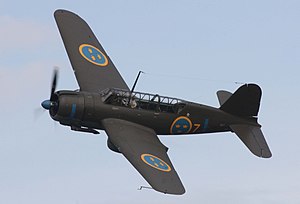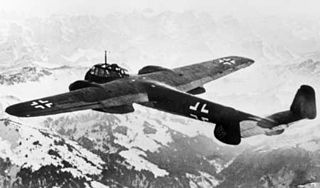
The Dornier Do 215 was a light bomber, aerial reconnaissance aircraft and later a night fighter, produced by Dornier originally for export, but in the event most served in the Luftwaffe. Like its predecessor, the Dornier Do 17, it inherited the title "The Flying Pencil" because of its slim fuselage. The successor of the Do 215 was the Do 217.
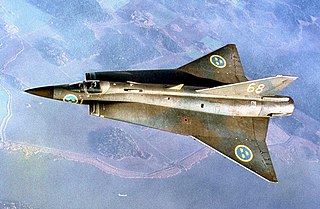
The Saab 35 Draken is a Swedish fighter-interceptor developed and manufactured by Svenska Aeroplan Aktiebolaget (SAAB) between 1955 and 1974. Development of the Saab 35 Draken started in 1948 as the Swedish air force future replacement for the then also in development Saab 29 Tunnan day fighter and Saab 32B Lansen all-weather fighter. It featured an innovative but unproven double delta wing, leading to the creation of a sub-scale test aircraft, the Saab 210, which was produced and flown to test this previously-unexplored aerodynamic feature. The full-scale production version entered service with frontline squadrons of the Swedish Air Force on March 8, 1960. It was produced in several variants and types, most commonly as a fighter-interceptor.
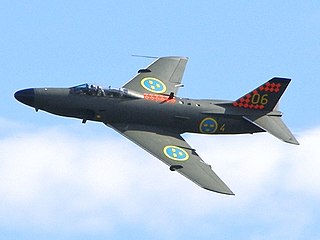
The Saab 32 Lansen is a two-seat, transonic military aircraft designed and manufactured by the Swedish aircraft manufacturer Saab AB.

The Handley Page HP.52 Hampden is a British twin-engine medium bomber that was operated by the Royal Air Force (RAF). It was part of the trio of large twin-engine bombers procured for the RAF, joining the Armstrong Whitworth Whitley and Vickers Wellington. The Hampden was powered by Bristol Pegasus radial engines but a variant known as the Handley Page Hereford had in-line Napier Daggers.

The Handley Page Halifax is a British Royal Air Force (RAF) four-engined heavy bomber of the Second World War. It was developed by Handley Page to the same specification as the contemporary twin-engine Avro Manchester.

The Junkers Ju 86 is a monoplane bomber and civilian airliner designed and produced by the German aircraft manufacturer Junkers.

The Saab 29 Tunnan, colloquially also Flygande Tunnan, is an early jet-powered fighter aircraft designed and produced by the Swedish aircraft manufacturer Saab. It was the second turbojet-powered combat aircraft to be developed in Sweden, the first being the Saab 21R, and it was the first Western European fighter to be produced with a swept wing after the Second World War, only being preceded in Western Europe as a whole by the Messerschmitt Me 262 built during the conflict.

The Saab 210 is an approximately 70% scale research prototype for the double-delta configuration of the Saab 35 Draken supersonic fighter. It became known by the unofficial nickname Lilldraken. Its first flight was on 21 January 1952.

The Northrop A-17, also known as the Northrop Model 8, a development of the Northrop Gamma 2F model, is a two-seat, single-engine, monoplane, attack bomber built in 1935 by the Northrop Corporation for the United States Army Air Corps. When in British Commonwealth service during World War II, the A-17 was called Nomad.

The Saab 18 was a twin-engine bomber and reconnaissance aircraft, designed and built by Svenska Aeroplan AB (SAAB) for use by the Swedish Air Force in response to a 1938 design competition. Due to delays, it did not enter service until 1944, but quickly became the standard Swedish bomber aircraft. Serving in the bomber, reconnaissance and ground-attack roles, it also assisted in the development of ejection seats and air-to-surface guided missiles until its replacement by the Saab Lansen in the late 1950s.

The RyanNavion is a single-engine, unpressurized, retractable gear, four-seat aircraft originally designed and built by North American Aviation in the 1940s. It was later built by Ryan Aeronautical Company and the Tubular Steel Corporation (TUSCO).

The SAAB 21 is a Swedish single-seat low-wing monoplane fighter and attack aircraft designed and manufactured by SAAB. Its twin boom fuselage with a pusher engine gave the aircraft an unusual appearance.

The FFVS J 22 was a Swedish single-engine fighter aircraft developed for the Swedish Air Force during World War II.

The Fokker C.V was a Dutch light reconnaissance and bomber biplane aircraft manufactured by Fokker. It was designed by Anthony Fokker and the series manufacture began in 1924 at Fokker in Amsterdam.
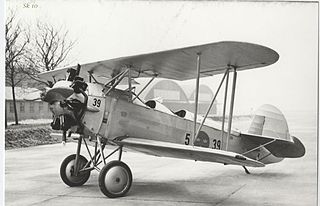
Raab-Katzenstein RK-26 Tigerschwalbe, also known as the Fieseler F 1 Tigerschwalbe, was a German twin-seat biplane trainer aircraft designed by Gerhard Fieseler by the end of the 1920s.
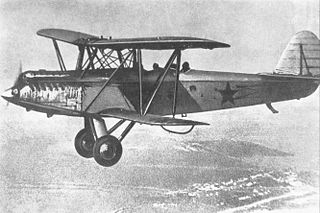
The Polikarpov R-5 was a Soviet reconnaissance bomber aircraft of the 1930s. It was the standard light bomber and reconnaissance aircraft of the Soviet Air Force for much of the 1930s, while also being used heavily as a civilian light transport, some 7,000 being built in total.
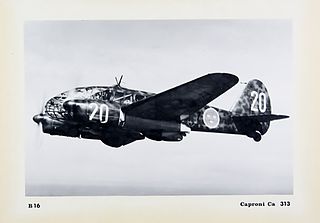
The Caproni Ca.313 was an Italian twin-engine reconnaissance bomber of the late-1930s. It was a development of the Ca.310. Its variants were exported to several other countries.
The Piaggio P.32 was an Italian medium bomber of the late 1930s, produced by Piaggio, and designed by Giovanni Pegna. It was a modern design for its time, but was a failure due to lack of powerplants commensurate with its high wing loading.

The Caproni Ca.113 was an advanced training biplane produced in Italy and Bulgaria in the early 1930s. Designed as a follow-on to the Ca.100, it was a more powerful and robust aircraft capable of aerobatics. It was a conventional design with two cockpits in tandem, single-bay staggered wings of equal span, and mainwheels covered by large spats.

The Bofors 57 mm m/47 aircraft gun was a Swedish aircraft gun developed by Bofors AB for the T 18B, a Swedish torpedo bomber manufactured by SAAB. The designation "57 mm automatkanon m/47" is translated to "57 mm autocannon model 1947". It is referred to as the Bofors 57 mm type L50 by the manufacturer.
